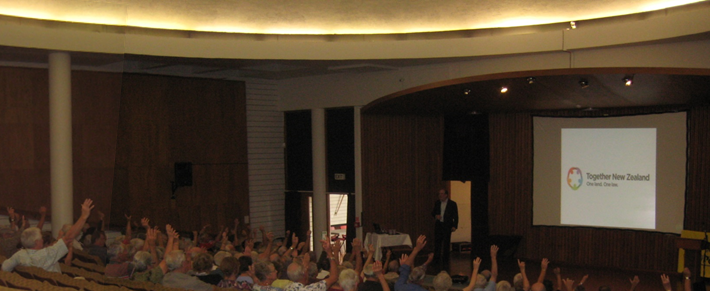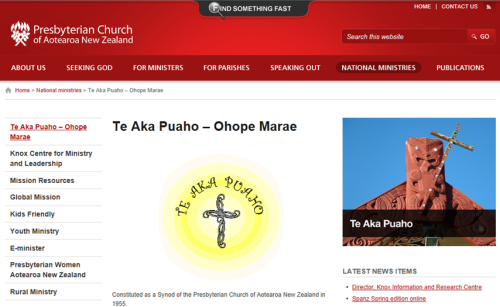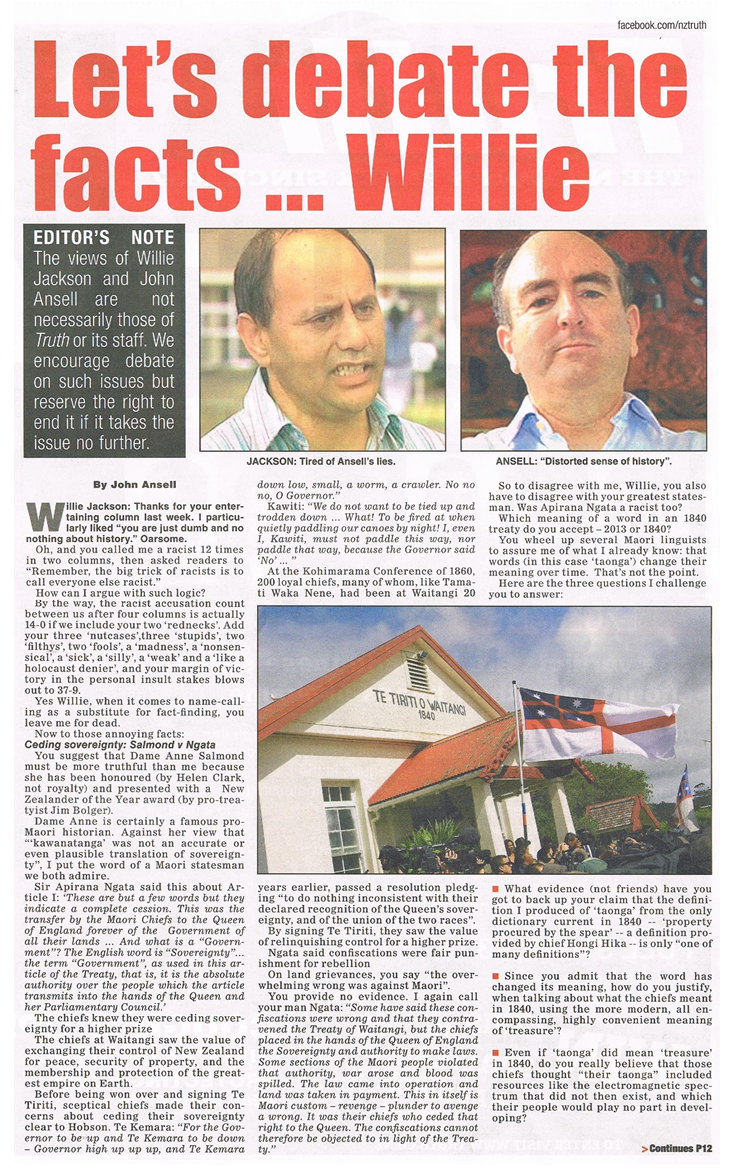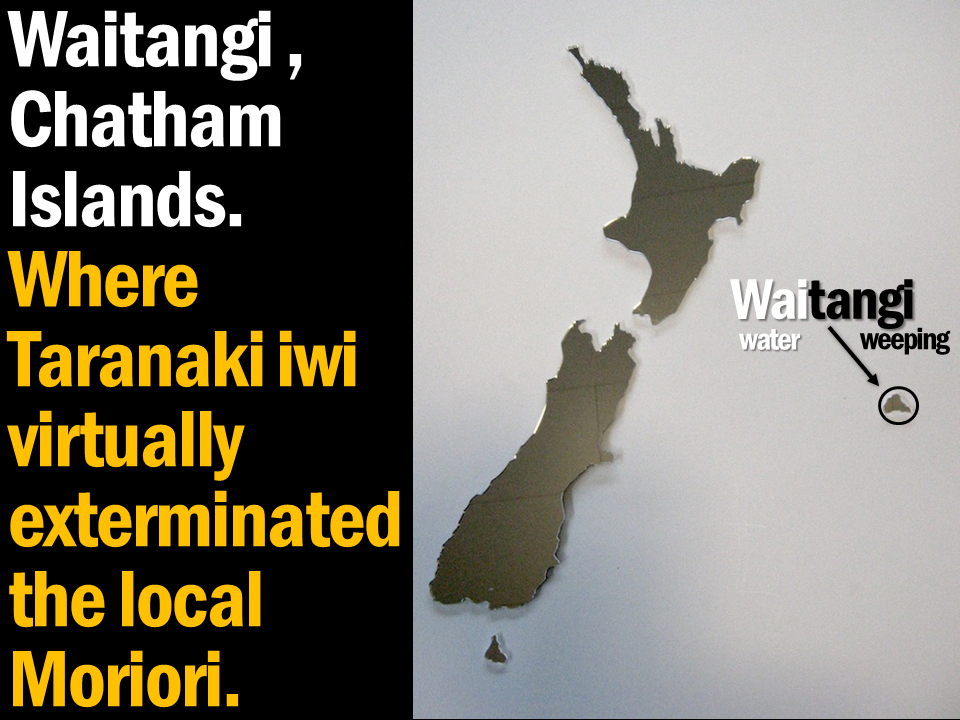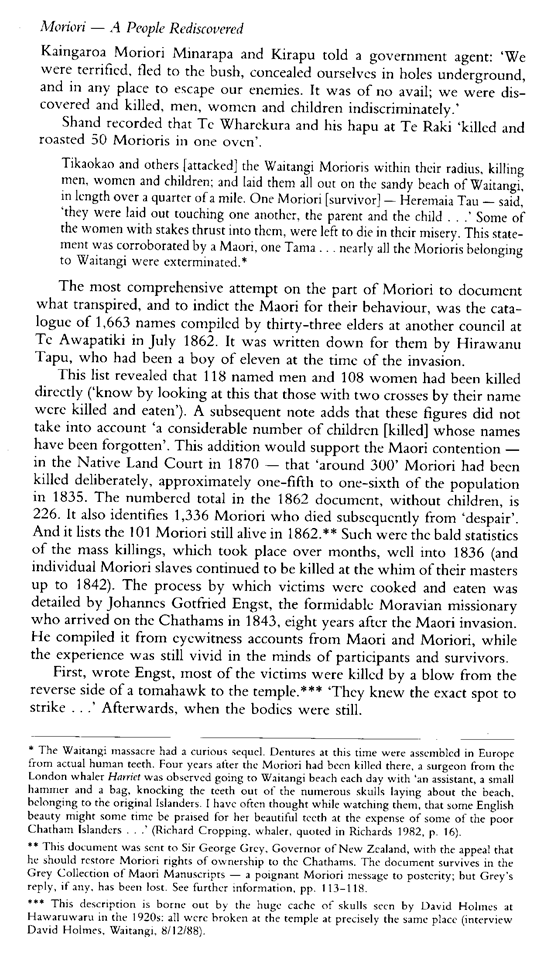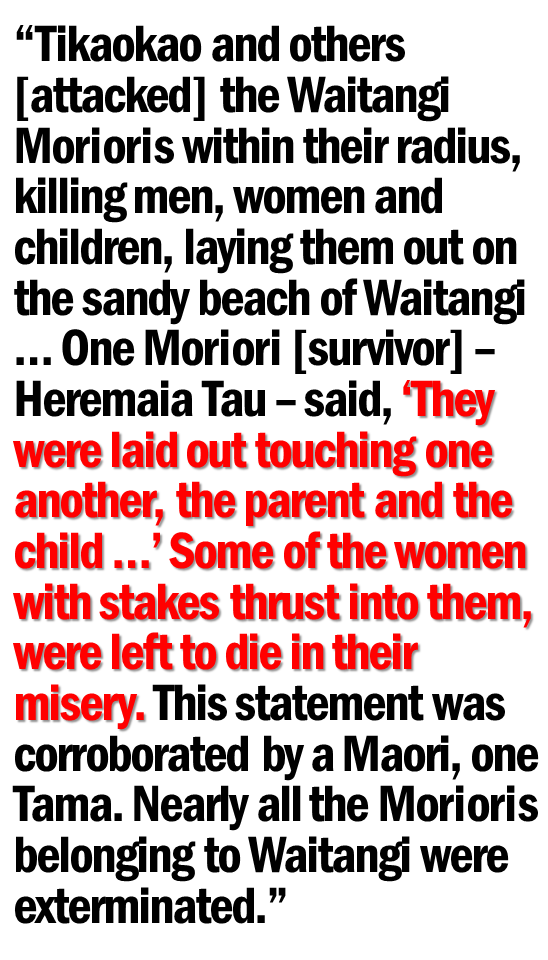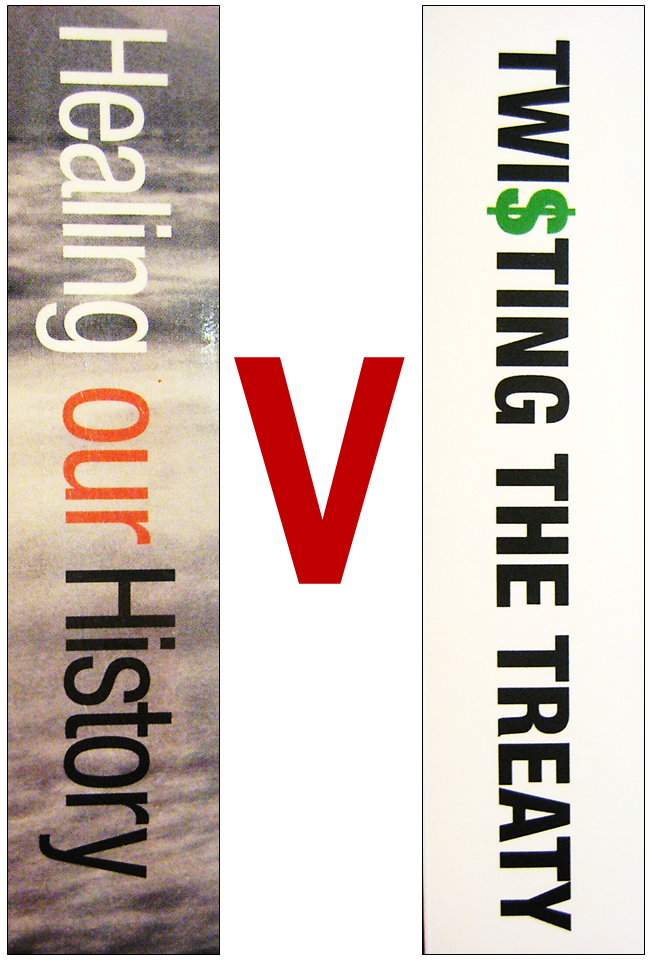
You may remember on Willie and JT’s radio show, a woman rang up bemoaning my grasp of Crown-Maori history.
She had, it seems, been to university. And knew better.
Quite what a history course at one of New Zealand’s bastions of biculturalism had to do with actual history, she didn’t say.
She did, rather tellingly, point out that, of all the authors featured in her university library, only one — Stuart Scott — would have taken issue with the world according to Jackson and Tamihere.
Which says it all about the impartiality of our state education system. I was surprised there were as many as one.
(How Scott’s excellent The Travesty of Waitangi got past the bicultural commissars is a mystery.)
I commended to her the works of half a dozen other authors that she should read for balance — a concept her professors would not have understood.
She commended to me a book by Robert and Joanna Consedine called Healing our History — The Challenge of the Treaty of Waitangi.
By a stroke of luck, I told her, I happened to be reading that book at the moment.
I was also reading the new bombshell volume Twisting the Treaty — A Tribal Grab for Wealth and Power.
And it occurred to me that these two books, with their oddly symmetrical titles, really serve as manuals for their respective sides of the Treaty debate.
Then Dr John Robinson, one of the authors of Twisting the Treaty — as well as The Corruption of New Zealand Democracy and When Two Cultures Meet — told me that he, too, was reading Healing our History.
I asked what he thought of it. This was his reply.
(Photo, caption, and type layout by me.)
_________________________
REVIEW
by Dr John Robinson
of
HEALING OUR HISTORY —
The Challenge of the Treaty of Waitangi
by Robert and Joanna Consedine
This book has been referred to as the definitive Treatyists’ manual.
Reading it took me back to the last time I attended a seminar at the Treaty of Waitangi Research Unit at Victoria University, more than a decade ago.
That seminar, on the Treaty of Waitangi as presented by the Treaty bus then touring the country, took the form of a true believers’ revivalist meeting, leaving me extremely uncomfortable.

Sealing the sales of Healing our History:
praise from the Treatifarians’ patron saint Claudia.
The speaker preached the dogma, and there was no intelligent comment. That was far from a true university, where questions are asked and information is tested.
This book has the same credulous feel about it, as if preaching to the converted. But when questioned, much of the argument is seen to be specious.
________________________
Dr John Robinson on the Treaty of Waitangi Research Unity at Victoria University:
That Unit depended on the goodwill of the Waitangi Tribunal and the Crown Fisheries Trust for funding, and Director Richard Hill had to keep in their good books to assure his employment and promotion to Professor. We were all expected to join in the Church of Treaty Grievance.
________________________
This is a sad book, for Robert Consedine is a fine person, who has done much to aid people in need.
But he is credulous, and too ready to accept unquestioningly any opinion that supports the grievance thesis that:
- Maori have been hard-treated and cheated by colonisation
- colonisation is always the same, and always an unmitigated disaster
- all non-Maori (but not Maori with European blood) should carry a guilt trip.
Along with that is an acceptance of the recent rewriting of the Treaty of Waitangi.
This has been transformed from a document setting up a united nation to a blueprint for separatism and partnership between two divided races — with different laws for each, and different rights.
I comment on some of the points in the book that supposedly build the case for a belief in white wrongdoing, with its severe critique of colonisation.
These illustrate the Consedines’ habit of accepting anything that suits their cause.
Colonisation
The simplistic treatment of an always-bad colonisation intermingles some five centuries of actions by different peoples, as if this was a uniform continuity, and all Europeans the same.
Thus:
“The colonial era began towards the end of the fifteenth century with the rise of European powers built on the spoils of conquest of America, Africa and Asia”
together with the claim that:
“The economic motivation behind colonisation was unchanged.”
(Pages 42 and 43.)
Here the British actions in 1840 are confounded with the horrors of other colonisations, such as Cortez in Mexico, Pizzaro in Peru, and the later Belgians in the Congo.
The Age of Enlightenment and the British fight against slavery are ignored.
That evolution of an enlightened and inclusive policy is outlined in the chapter ‘British Society at the Time of Meeting’ of When Two Cultures Meet — The New Zealand Experience.
We should be proud of British colonisation, how it was carried out, and what was achieved.
Consedine, an Irish Catholic, is intent on complaining loudly of the wrongs of the British in the land of his ancestors, with six sections on Ireland:
- ‘Ireland: The Patent Figures Lied to Us’
- ‘The [Anti-Catholic] Penal Laws’
- ‘The Potato Famine 1845-52’
- ‘The Creation of Northern Ireland’
- ‘The Discrimination Continues’ and
- ‘An Economic Issue’ (where he says that: “On the surface the Irish troubles are always presented as a religious issue, but in fact they are an economic issue.’)
The history of New Zealand and of the Treaty of Waitangi has nothing in common with the much longer and particular story of the British in Ireland.
The Consedines’ aim here is to blacken the name of the British as “the colonisers”, with stories of claimed wrongs in other places, and not to tell the real story of what British intentions were in New Zealand, of Maori hopes for peace, or of the complex events leading up to and following 1840.
Dependency
The Consedines correctly quote (their page 117) the New Zealand Institute for Economic Research Māori Economic Development, Te Ōhanga Whanaketanga Māori (2003), who say that
“While Māori households indeed receive $2.3 billion (see Table 3) in fiscal transfers, this is offset by a tax contribution of $2.4 billion from the Māori economy.”
Indeed, this is true, as according to the numbers in the table Maori households contribute more in tax than they receive in benefits and other fiscal transfers.
But taxation is for a lot more than that, for a wide range of services (hospitals, police, schools, etc.) — not only for benefits.
And that considerable range of services is NOT well supported by Maori.
The great majority of the taxes from Maori are taken straight back by benefit payments – $2.31 billion of $2.40 billion, or 96%.
The result is that Maori provide (after benefit payments are returned to them) $92 million of general cost taxation, compared to $20,982 million from non-Maori.
Maori (10% of the population or more) provide just 0.44% of non-benefit taxes for governance and public services.
That is not a fair share.
Another way of commenting on the numbers is that Maori take back almost all of their taxation in benefits, and make a negligible contribution to the cost of government services, which they receive, and which are almost completely financed by non-Maori.
The NZIER claims that such “conclusions transform the frequently promoted myth that Maori are a drag on the New Zealand economy”.
Surely this shows the very opposite.
There are many such examples of ridiculous statements that are readily accepted and repeated until they become part of the new history.
In this, as in so many ways, the Consedines do a great disservice by failing to question such spin.
Too many ‘authorities’ get away with telling porkies, and are well paid for doing so.
Population and intertribal war
The killing by Maori of around one-third of the Maori population in the horrific intertribal warfare of 1800 to 1840 is downplayed.
“Lawyer R D Crosby estimates that between 50,000 and 60,000 Maori were killed, enslaved or forced to migrate from 1810-1840.
“However, demographer Ian Pool, on whom Crosby partly draws, points out that ‘100,000 persons would have expected to have died in that thirty year period in the ‘normal course of events’ with or without war.”
(Page 83)
Pool’s suggestion that the killing of around one-third of the population in that savage warfare in 30-40 years (with a considerable proportion in the one decade of the 1820s) had no great impact on population or life style, is simply incredible.
But if an authority figure says so, it must be true to the credulous believers.
I have dealt with this at some length in my When Two Cultures Meet — The New Zealand Experience. Not because such nonsense should be taken seriously.
And not because Pool makes any cogent argument. Or because the real point is difficult to grasp. (That the loss of one-third of men, women and children has a great impact on population both immediately and in the future.)
But because Pool has been believed without any question raised.
From an examination of the data, and many eyewitness accounts, it is easy to determine the consequences of that killing — which was a great demographic imbalance that had an impact throughout the remainder of the eighteenth century.
The cause of Maori population decline through the whole of the eighteenth century was that intertribal war. Not colonisation.
Indeed, the Treaty and assertion of British sovereignty brought an end to widespread intertribal warfare — as well as to slavery, cannibalism and female infanticide.
The desire by a number of Maori chiefs to put an end to that warfare by the introduction of a powerful central force was, in fact, a significant reason for the welcome given to the Treaty of Waitangi — and repeated at Kohimarama in 1860.
Health and life expectancy
We find Pool again in a claim that:
“In the eighteenth century Maori life expectancy equalled that of the wealthier inhabitants of Europe and ‘was well above that of countries such as Spain and Italy’.”
(Page 81.)
This would suggest that any Maori poor health was a consequence of colonisation.
It is false. Life expectancy for Maori was about 25 years before colonisation.
Waitara
The considerable effort by the British to determine land ownership fairly is an important, and significant, part of our history.
The troubles were substantial, with claims by existing residents, returning freed slaves, returning warriors, and recent conquerors.
While one person would own the land, a chief might insist that traditional control should continue.
(Which, if allowed, would remove the right of the willing seller to be able to act as a free British subject who was no longer beholden to a former overlord.)
This is what happened at Waitara, where the disagreement was the consequence of a long-lasting feud among Maori.
Thus Kingi wished to overrule Teira because Rimene had some years before seduced the wife of Ihaia.
The full, complex and fascinating story is well reported in historical accounts.
I have summarised much of this in When Two Cultures Meet — The New Zealand Experience, drawing on two very informative and comprehensive historical accounts.
(Cowan New Zealand Wars and the Pioneering Period, Volumes 1 and 2, 1922 and 1923, and Wells The History of Taranaki, 1857.)
Here we find the paper-thin modern version, trimmed down so as to have become quite misleading:
“A series of events starting at Waitara in 1860, where the Crown attempted to take land that Maori leadership refused to sell, quickly led to a period know as the Land Wars.”
(Pages 93-94.)
The Crown did not “take land”. It purchased from a willing seller, Teira — who even Kingi recognised as the owner.
The rewriting of history cheapens a human story, and robs us all of a fascinating and often dramatic historical birthright.
Parihaka
The standard modern version as given by the Consedines presents Government (called the Crown) action at Parihaka in 1881 as shameful.
Yet the settlement of Parihaka under Te Whiti’s leadership was clearly illegal, as the land had been properly and legally confiscated — as punishment for rebellion.
(In accordance with both British law and in Maori culture.)
And many attempts had been made to negotiate with Te Whiti.
As with Waitara (above) and the writing of the Treaty of Waitangi (below), the full story is far more fascinating than the simplistic fabricated version, which was used by the Waitangi Tribunal to describe those events as “the pillaging of Parihaka” and an example of “the Maori holocaust”.
The one casualty was a boy whose foot was trodden on by a horse.
And far from being pacifist, there was at Parihaka a stockpile of around 250 weapons including breechloaders, Enfields, revolvers and a variety of ammunition.
A comprehensive account is given by Bruce Moon in the chapter ‘Parihaka — The Facts’ in Twisting the Treaty –A Tribal Grab for Wealth and Power.
Treaty of Waitangi, shared sovereignty
The Consedines include (in Appendix 2) Te Tiriti o Waitangi 1840 in Maori, together with a translation into English, and “The Treaty of Waitangi: an English version 1840”.
The translation is by Hugh Kawharu in 1973.
It differs significantly from the many other translations in and after 1840, including that in an article by Sir Apirana Ngata in 1922.
Kawharu altered the meaning of words, which were formerly clearly understood and agreed upon by all.
There is no such thing as “an English version”. There is only one true version of the Treaty, and this is in Maori.
The “version” given is a draft prepared by Hobson’s secretary, and dismissed by Hobson before the final English draft was prepared and then translated into the Treaty.
That secretarial draft is a confusing document, and is internally inconsistent.
- On the one hand, British law is to apply.
- On the other, Maori are given control of “fisheries” — that are not privately owned in British law.
How could Hobson have spent several years discussing and being advised on this Treaty, and then come up with such a mess?
The answer is that he did not.
The full story is given by Bruce Moon in the chapter “Real Treaty: false Treaty, the true Waitangi Story”, in Twisting the Treaty — A Tribal Grab for Wealth and Power.
Healing our History — The Challenge of the Treaty of Waitangi is a lazy work, parroting the new accepted dogma of colonial guilt and blameless, hard-done-by Maori.
The reality is far more complex, richer and more interesting.
These and other important points have been treated in depth by the six authors, and the editor, who have contributed chapters to Twisting the Treaty — A Tribal Grab for Wealth and Power, which is essential reading for anyone with an interest in the Treaty of Waitangi.

Don’t believe me or John Robinson:
read both of these books.
_________________________
Thanks to John Robinson for another valuable contribution to the debate.
If Robert and/or Joanna Consedine (or their endorser, Dame Claudia Orange, for that matter) would like to write a review of Twisting the Treaty, I’d be more than happy to run it!
And if you haven’t grasped the hint from all my links, don’t forget to order your copy here.
